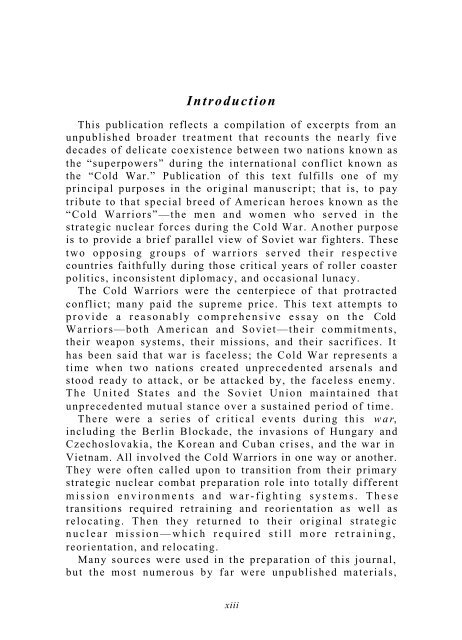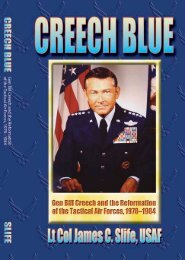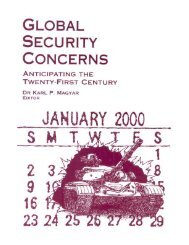Inside the Cold War - Project Gutenberg Consortia Center
Inside the Cold War - Project Gutenberg Consortia Center
Inside the Cold War - Project Gutenberg Consortia Center
You also want an ePaper? Increase the reach of your titles
YUMPU automatically turns print PDFs into web optimized ePapers that Google loves.
Introduction<br />
This publication reflects a compilation of excerpts from an<br />
unpublished broader treatment that recounts <strong>the</strong> nearly five<br />
decades of delicate coexistence between two nations known as<br />
<strong>the</strong> “superpowers” during <strong>the</strong> international conflict known as<br />
<strong>the</strong> “<strong>Cold</strong> <strong>War</strong>.” Publication of this text fulfills one of my<br />
principal purposes in <strong>the</strong> original manuscript; that is, to pay<br />
tribute to that special breed of American heroes known as <strong>the</strong><br />
“<strong>Cold</strong> <strong>War</strong>riors”—<strong>the</strong> men and women who served in <strong>the</strong><br />
strategic nuclear forces during <strong>the</strong> <strong>Cold</strong> <strong>War</strong>. Ano<strong>the</strong>r purpose<br />
is to provide a brief parallel view of Soviet war fighters. These<br />
two opposing groups of warriors served <strong>the</strong>ir respective<br />
countries faithfully during those critical years of roller coaster<br />
politics, inconsistent diplomacy, and occasional lunacy.<br />
The <strong>Cold</strong> <strong>War</strong>riors were <strong>the</strong> centerpiece of that protracted<br />
conflict; many paid <strong>the</strong> supreme price. This text attempts to<br />
provide a reasonably comprehensive essay on <strong>the</strong> <strong>Cold</strong><br />
<strong>War</strong>riors—both American and Soviet—<strong>the</strong>ir commitments,<br />
<strong>the</strong>ir weapon systems, <strong>the</strong>ir missions, and <strong>the</strong>ir sacrifices. It<br />
has been said that war is faceless; <strong>the</strong> <strong>Cold</strong> <strong>War</strong> represents a<br />
time when two nations created unprecedented arsenals and<br />
stood ready to attack, or be attacked by, <strong>the</strong> faceless enemy.<br />
The United States and <strong>the</strong> Soviet Union maintained that<br />
unprecedented mutual stance over a sustained period of time.<br />
There were a series of critical events during this war,<br />
including <strong>the</strong> Berlin Blockade, <strong>the</strong> invasions of Hungary and<br />
Czechoslovakia, <strong>the</strong> Korean and Cuban crises, and <strong>the</strong> war in<br />
Vietnam. All involved <strong>the</strong> <strong>Cold</strong> <strong>War</strong>riors in one way or ano<strong>the</strong>r.<br />
They were often called upon to transition from <strong>the</strong>ir primary<br />
strategic nuclear combat preparation role into totally different<br />
mission environments and war-fighting systems. These<br />
transitions required retraining and reorientation as well as<br />
relocating. Then <strong>the</strong>y returned to <strong>the</strong>ir original strategic<br />
nuclear mission—which required still more retraining,<br />
reorientation, and relocating.<br />
Many sources were used in <strong>the</strong> preparation of this journal,<br />
but <strong>the</strong> most numerous by far were unpublished materials,<br />
xiii






